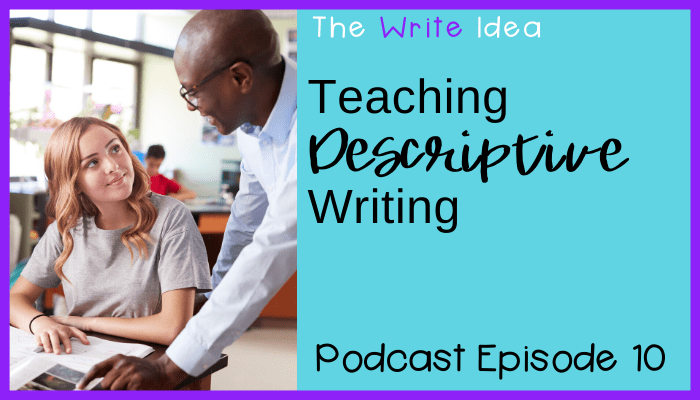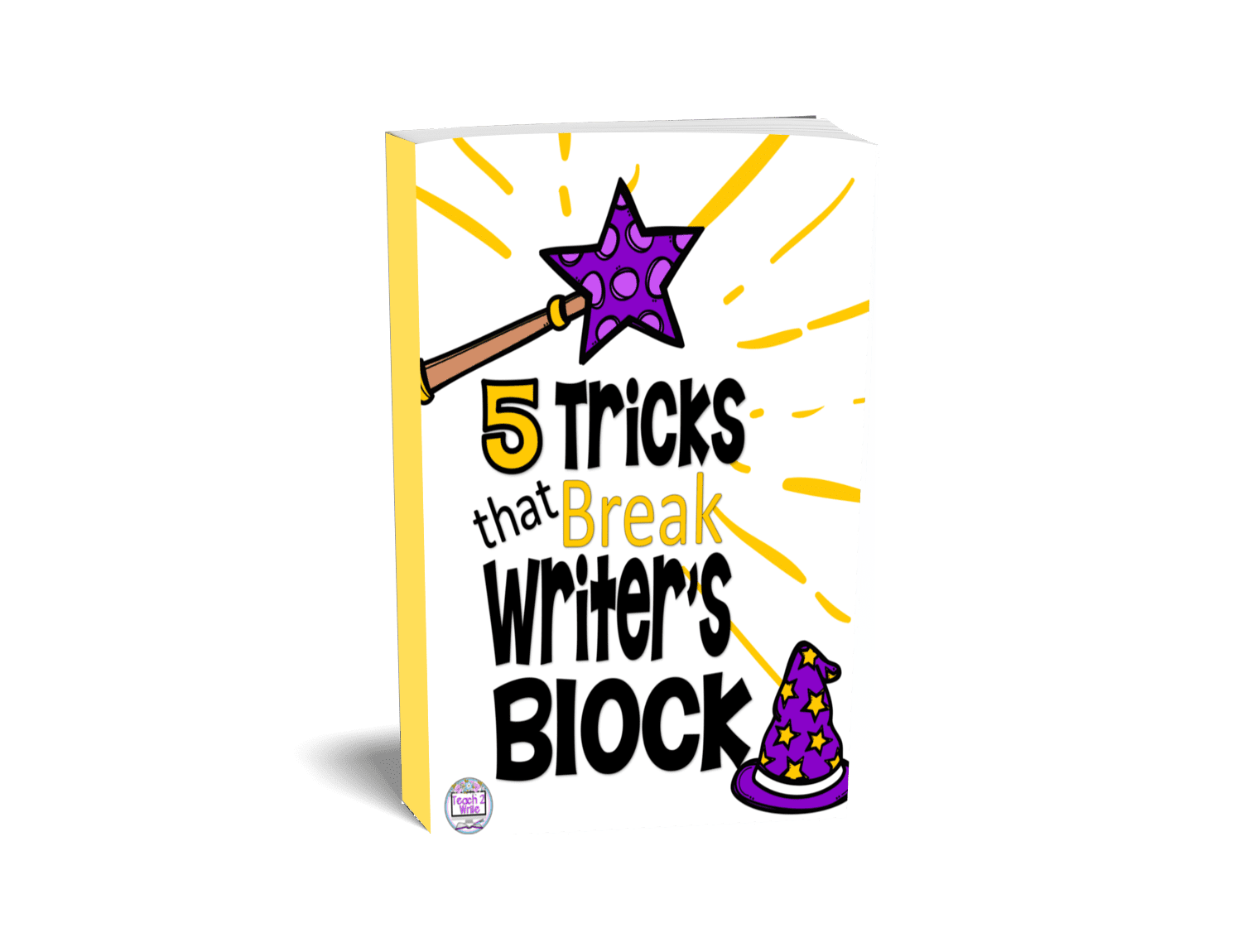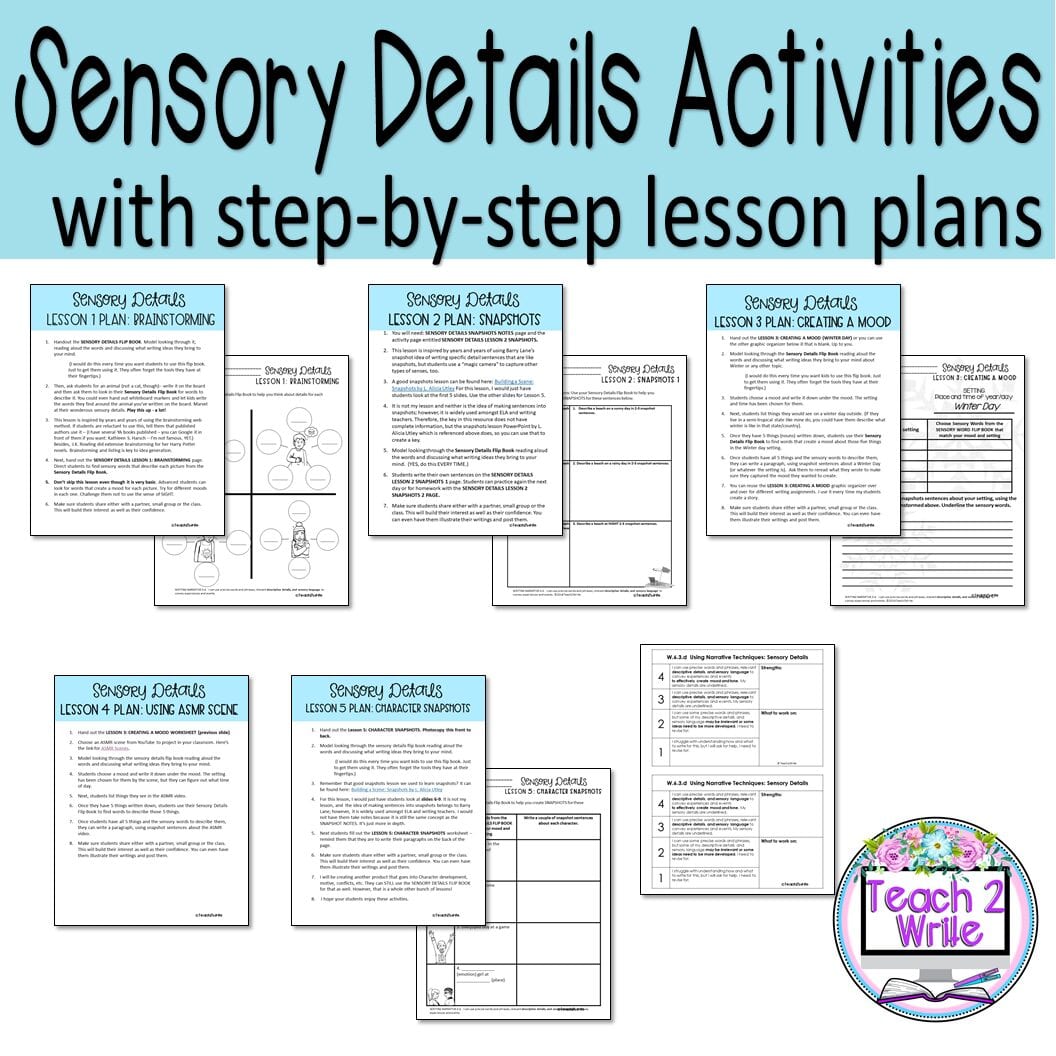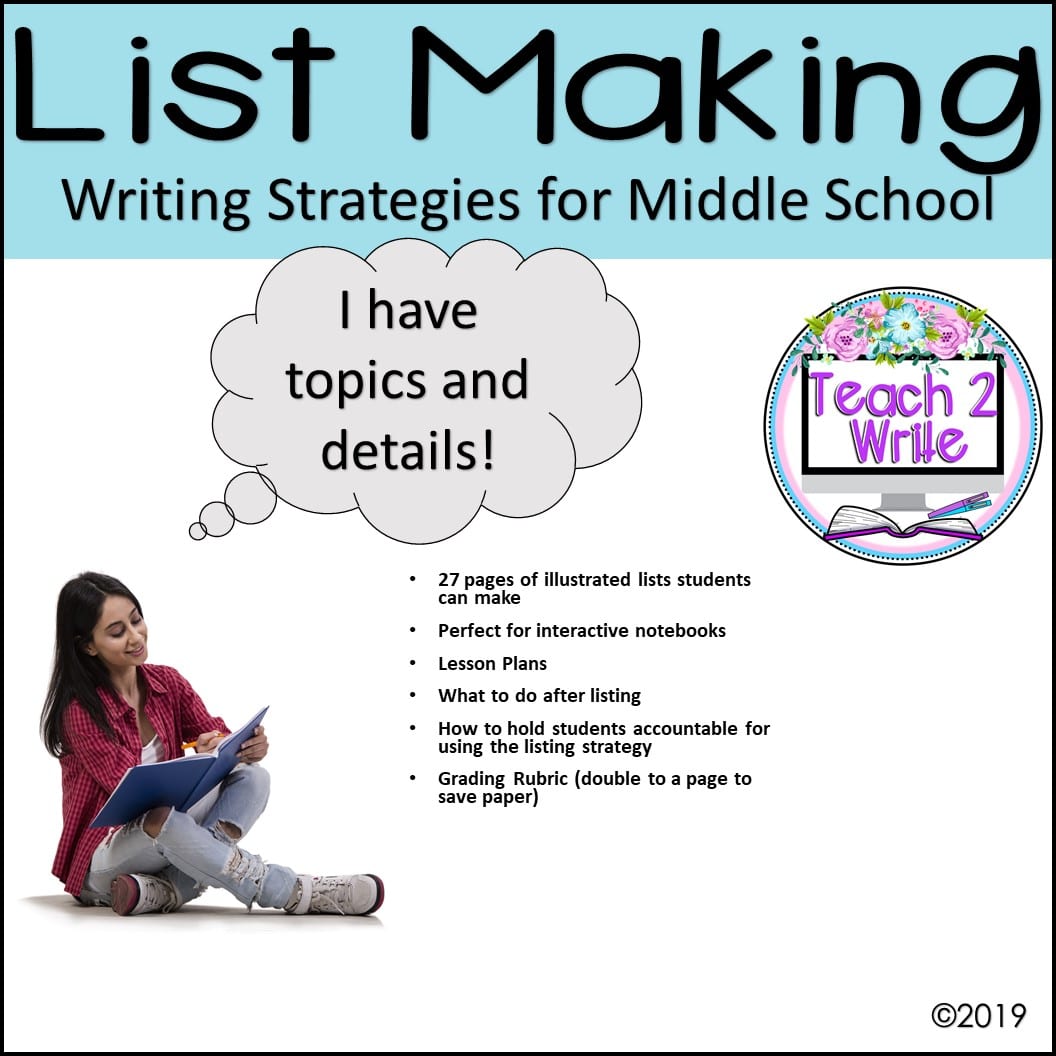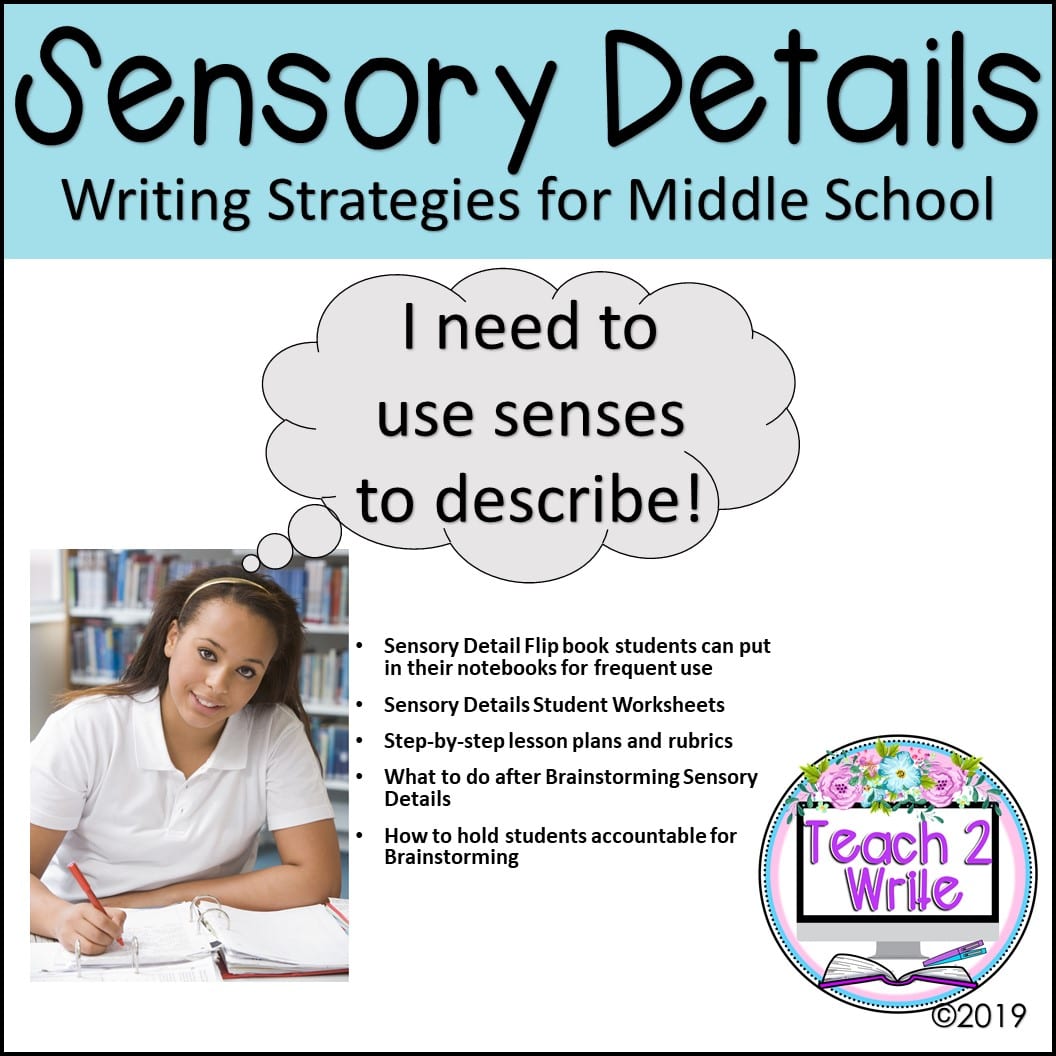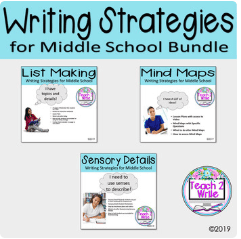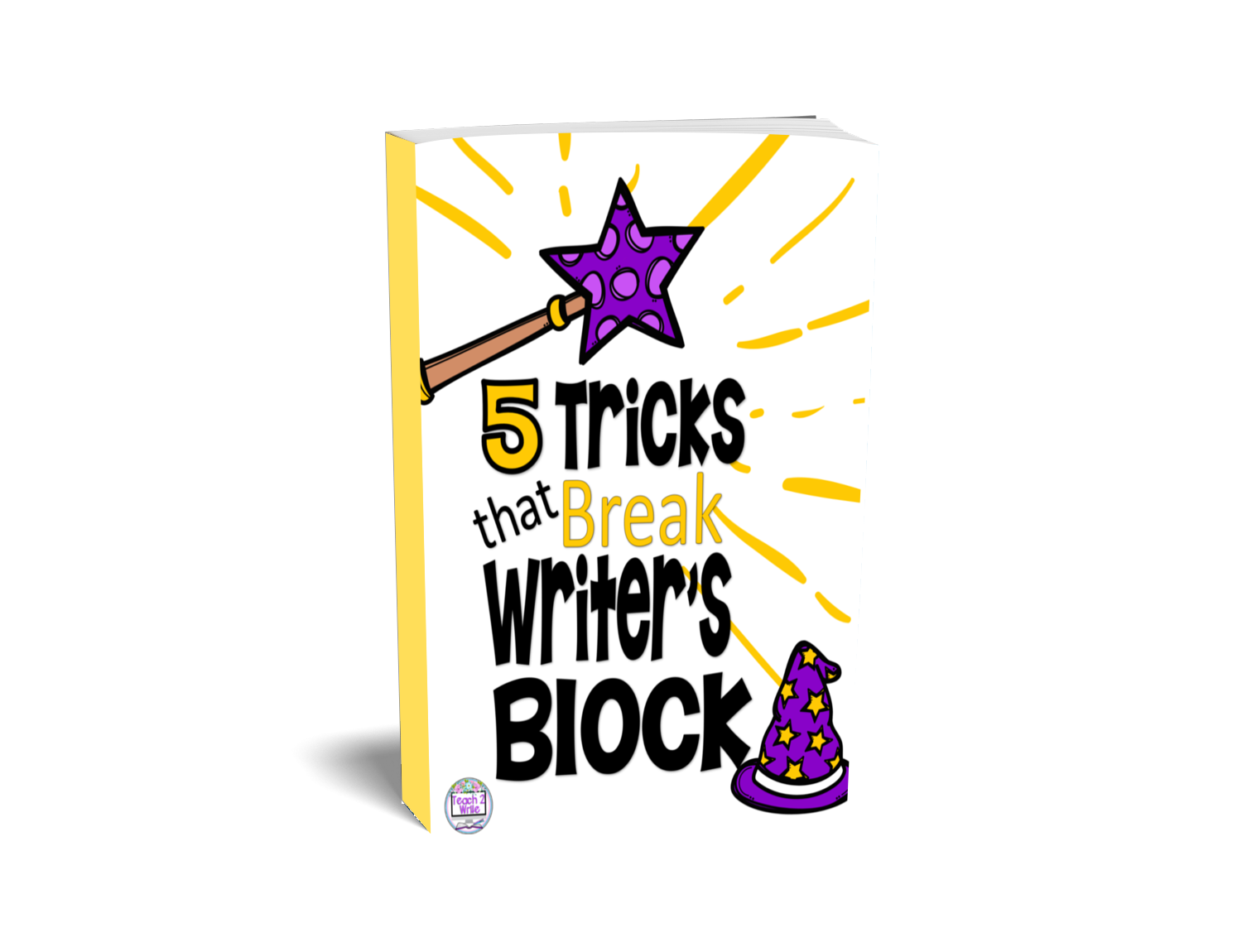Teaching descriptive writing by telling writers to “SHOW, not tell” is ineffective. Writers need to know what you mean by “SHOW.”
Description requires a lot more thinking from a writer, to coordinate sensory details, powerful action verbs and specific nouns to work together and to create a mood.
Because it takes time to learn this coordination of word choices, students need to be explicitly taught how to describe. This must be followed by lots of practice. I learned that the hard way this year. I gave students only a week to practice describing before going on to a new concept. When I assessed the previous week’s assignment, I realized they needed much more practice. That’s why writing description is the second concept I focus on for the school year. (Of course, after I teach students how to generate ideas through mind mapping and listing.)
You can find the idea generating strategies, I’m referring to in the 5 Tricks that Break Writer’s Block Teacher’s Guide. Click on the image below:
So, why is teaching descriptive writing so vital for writers?
According to Barry Lane, author of “After the End,” and “Discovering the Writer Within,” writers go back and forth between description and thought. He explains that we write descriptions from a “sea of experience” and thoughts about those experiences, or our “mountain of perception.”
This sea of experience, described through the lens of perception, depends on the mood a writer is feeling at the time of the experience. A person in a rotten mood is going to think of a summer day as “hot and blinding,” “itching and burning.” However, a person in a great mood might describe a summer day as “bright and cheerful,”and “warm and inviting.”
We have to teach writers how to access their sea of experiences. To think about what something looked like, smelled like, tasted like. So, students can then describe these experiences to their readers.
Kids really struggle with elaboration. Elaboration requires description and analysis. When writing descriptions, I’ve often found that students either use color words or vague words like big, small, nice. These kinds of vague adjectives really don’t add to the meaning and tone of a piece of writing.
Even my best writers in the classroom will resort to those easier word choices because they take minimal effort.
Sensory Details important for engagement
Another reason why writing description is so important is because humans understand the world through sensory information. When we read, sensory details activate the same area in our brains as they would if we actually experienced those things in real life.
For example, if I say the word cupcake, my friend, Jamie might be thinking peanut butter and chocolate cupcakes. While my son, Danny, might be thinking strawberry with vanilla frosting. Everyone who heard this word “cupcake” would get a different picture in their heads of flavor, icing, filling and other decorations.
However, if I say chocolate cupcake oozing with caramel sauce, then the area in your brain that remembers chocolate cake and caramel sauce lights up. Suddenly, you want to experience those flavors again!
Reading those words engaged your senses.
The more senses you engage, the more you remember.Writers must recreate sensory experiences through description in order to activate their reader’s mind and keep it engaged.
Readers get bored easily. So, a writer must be able to immerse the reader in a fictional world and make it as real as possible. In a nonfiction piece, description is important to understand and remember concepts and events. Readers need to be able to visualize or experience the writer’s world by accessing these sensory experiences.
Teaching Description to Student Writers
Now, how do you teach students to include these necessary details in their descriptive writing?
First, students need a couple of important tools. One is mind mapping. The other is a sensory word list flipbook that helps students learn new words or to remember words they already know, but don’t use in their everyday conversations.
1. Mind Mapping helps students access details
By the time I teach descriptive writing, I’ve already taught mind mapping. So, writers have practiced mind mapping for at least a week in their writers journals before moving on to description. For more on mind mapping and writing journals, I encourage you to go back and listen to this podcast’s episodes 2 and 3 of The Write Idea.
2. Sensory Word Lists
The second tool we use is the Sensory Word List Flipbook, and like all tools my writers use, I explicitly teach how to use it.
First, I pass out my sensory word list flipbook that I’ve created and refined over the years, and students tape it into their writing journals. Next, I show students how the flip book list works.
The flip book is divided into the five senses, and is further divided into subcategories, like sound: pleasant and unpleasant or touch: textures and temperature.
3. Class Activity Description
Once students learn how the flipbook is laid out, I divide students into sensory groups, each group gets a different sense, and they come up with words to describe a specific object.
Together as a whole class activity, we mind map an object to describe. It can be any object in the room, but I often bring out a stuffed animal named Charlie. I pass Charlie around and students have fun trying to decide what he’s supposed to be – he could be a dog or bunny.
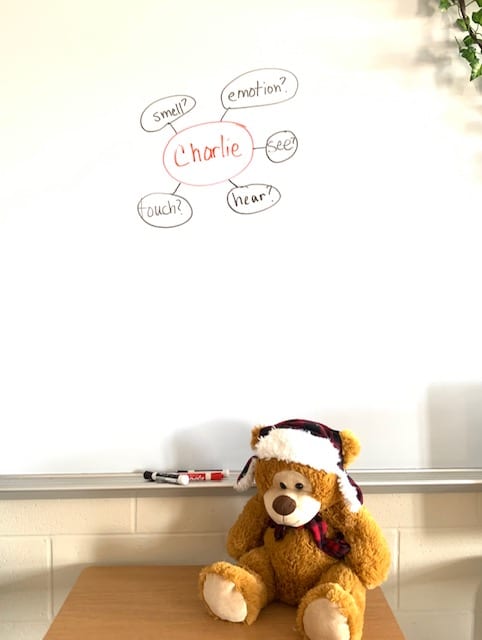
Once Charlie has been passed around, I send kids up to my board to write sensory words they find from the sensory word list flipbook that describes him. “Fuzzy, soft, spongy, matted fur, dilapidated bow tie, dusty relic, worn nose, glassy eyes, etc.”
Then, students use our class-created mind map to write descriptive sentences about Charlie. Or if I have a more advanced group, I have them write a few paragraphs about Charlie, which can be either realistic or fictional.
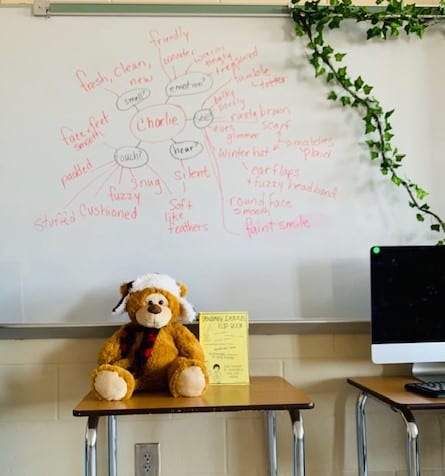
Adding Action Verbs and Specific Nouns
After I introduce sensory words, we talk about which words in the flipbook that could also be used as action verbs. Many of the sound words and some of the movement words are action verbs. I have students go through and mark those with an A.
Students then try to write sentences with both sensory adjectives and action verbs.
Once they learn this, we move on to specific nouns. For example – using words like German Shepard or Chihuahua instead of dog. Or Miami Dolphins instead of football team.
With all of these activities, students are primed for descriptive writing for the rest of the school year. We use mind mapping with descriptive words for stories, characters or events. We also use these words in lists or labeling drawings. When students revise, one of the steps I require is to make 5 word choice changes, using the sensory word list flipbook. Afterward, students highlight these 5 words in a particular color, so I can see their changes at a glance.
Creating Mood and Atmosphere with Description
Once students have learned how to describe, then I teach how to create mood and atmosphere. I talk about word connotations, and how certain words change our emotional perception of something.
For example, “The woman’s mud-brown eyes peered back at me,” gives a darker, almost sinister connotation. Meanwhile, “The woman’s chocolate brown eyes laughed,” gives a happier connotation.
By using certain adjectives like “mud-brown” and “chocolate brown” we create a different mood.
After learning how descriptive writing can manipulate mood and atmosphere, students can then identify those same types of descriptive details when analyzing a piece of text, like Edgar Allan Poe’s “The Raven” or Ambrose Bierce’s “An Occurrence at Owl Creek Bridge.” They can determining the mood these writers create through description.
Description is in every mode of writing from argumentative and persuasive to poetry and drama. It’s important to have students return to description from time to time. To keep it fresh in their minds, and to remind them of the necessity of creating a “sea of experience” for their readers.
To find out more about how you can help your student writers, click here.
For more teacher resources that help you in teaching descriptive writing:
Hey Writing Teachers! This is for You!
Transform your Writers!
5 Tricks that Break Writer’s Block Resources
Teaching writing doesn’t have to be complicated or take hours of grading. In fact, teaching students these 5 writing tricks, helps cut wasted time from late work, revision and grading!
These resources are my TOP FIVE writing strategies that I use with my students nearly every day throughout the school year. These strategies give my students and I the proven results of higher quality writing, less late work and less revision.

